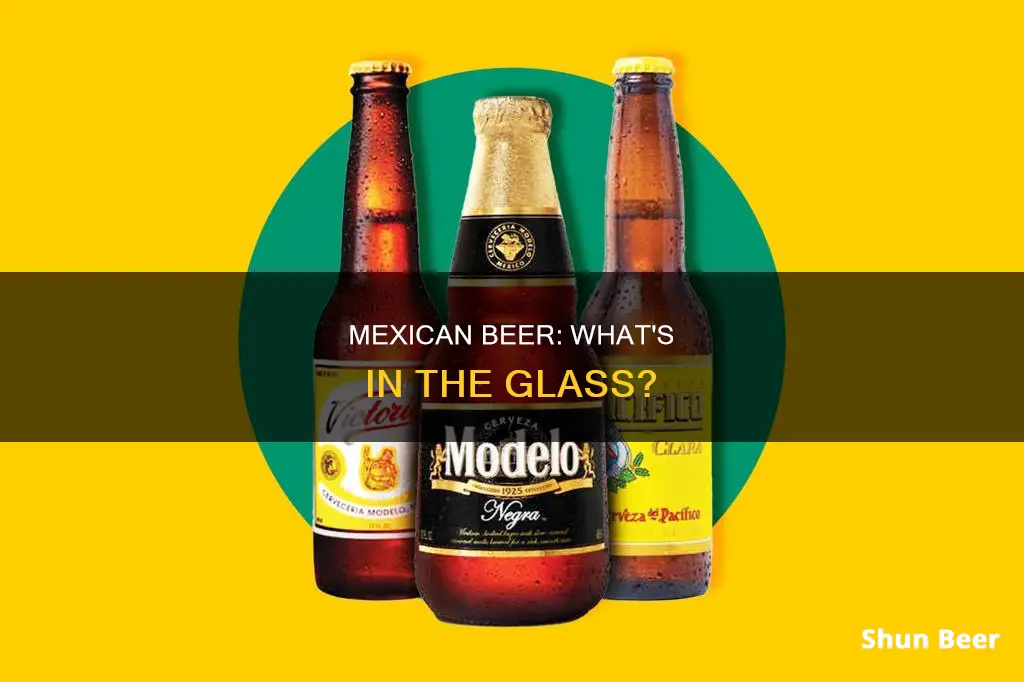
Mexico has a rich history of beer brewing, dating back to the Mesoamericans who were familiar with fermented drinks made from corn or agave long before colonisation. Beer is one of the country's major exports, and it is the world's largest beer exporter today.
The most popular beer in Mexico is Corona, which is also the best-selling Mexican beer worldwide. Other well-known beers are Tecate, Modelo, Dos Equis, and Sol. Almost all of the beer in Mexico is pale lager, with some variety from Bohemia and Leon, and the craft beer market is growing.
What You'll Learn

Mexican beer is largely produced by two corporations
The history of beer in Mexico dates back to the Spanish conquest of the Aztec Empire in the 16th century. While the Mesoamericans were already familiar with fermented alcoholic beverages, including corn beer, the Spanish introduced barley and wheat-based beers. However, production was limited due to a lack of available grains and heavy regulations and taxes imposed by Spanish authorities.
After the Mexican War of Independence, these restrictions were lifted, and the beer industry began to flourish. The arrival of German immigrants during the Second Mexican Empire brought additional knowledge and expertise, leading to the opening of many breweries across the country. By 1918, there were 36 brewing companies in Mexico.
Over time, the industry consolidated, and smaller breweries were absorbed by the "big two" corporations. Today, Grupo Modelo's brands include Corona, Corona Light, Negra Modelo, Modelo Especial, Victoria, Estrella, Leon, Montejo, and Pacifico. On the other hand, FEMSA's brands include Tecate, Sol, Dos Equis, Carta Blanca, Superior, Indio, and Bohemia.
While most Mexican beers are lagers, pilsners, Vienna-style light and dark beers, or Munich dark beers, craft breweries have also emerged in recent years, offering a wider variety of beer styles.
Beer Drinking and the Mystery of Missing Burps
You may want to see also

The country is the world's largest exporter of beer
Mexico is the world's largest exporter of beer, with its beers particularly popular in the US and Europe. In 2022, Mexico displaced the Netherlands as the largest worldwide beer exporter, with sales continuing to increase.
The country's two largest beer producers, Grupo Modelo and Cervecería Cuauhtémoc Moctezuma (formerly FEMSA Cerveza), control 90% of the Mexican beer market and distribute their products both domestically and abroad. Grupo Modelo's brands include Corona, Corona Light, Negra Modelo, Modelo Especial, Victoria, Estrella, León, Montejo, and Pacifico. Cervecería Cuauhtémoc Moctezuma's brands include Tecate, Sol, Dos Equis, Carta Blanca, Superior, Indio, and Bohemia.
The history of beer in Mexico dates back to the Spanish conquest of the Aztec Empire in the 16th century, when European-style beer brewed with barley was introduced. However, even before this, Mesoamerican cultures were familiar with fermented alcoholic beverages, including a corn beer known as pulque. After the Mexican War of Independence, restrictions on beer production disappeared, and the industry was allowed to develop further. The arrival of German immigrants during the Second Mexican Empire in the 19th century also contributed to the growth of the beer industry, as they brought additional knowledge and expertise. By the early 20th century, beer had become big business in Mexico, aided by prohibition in the United States, which led to a brisk trade of beer and other alcoholic beverages along the border.
Today, Mexico's beer industry is one of the most prevalent in the country, with over 63% of the population consuming one brand or another. The country's beer exports are also significant, with most going to the United States but available in over 150 countries worldwide.
Beer and OKD: Friend or Foe?
You may want to see also

Beer is usually served with lime juice
While the michelada is a popular way to drink beer in Mexico, it is not the only way. Beer is also commonly served with a wedge of lime, particularly with Corona, Estrella Jalisco, and Tecate. In fact, Corona is often served with a pinch of salt in addition to the lime wedge.
The addition of lime to beer, specifically Corona, is believed to have originated as a marketing ploy, similar to how Guinness is left to settle and Blue Moon is served with an orange slice. Over time, serving Corona with a lime became a ritual, and it is now expected and traditional. While some believe the lime improves the flavour of an otherwise bland beer, others think it is used to prevent flies from entering drinks, or to disguise the taste of skunked beer due to clear glass bottles.
Enjoying Beer on Naples Beach: What You Need to Know
You may want to see also

The most popular beer in Mexico is Corona
Mexico is the world's largest beer exporter, with its beers particularly popular in the US and Europe. The country has a rich history of beer brewing, which dates back to the Spanish conquest of the Aztec Empire in the 16th century. Even before this, ancient civilisations in Mexico were fermenting plants and corn grains to produce alcoholic beverages.
Today, the Mexican beer market is dominated by two major corporations: Cerveceria Modelo (Grupo Modelo) and Cerveceria Cuauhtemoc-Moctezuma (FEMSA). Together, they supply over 90% of all beer in Mexico.
Grupo Modelo's other popular beer brands include Modelo Especial, Victoria, Estrella, Leon, Montejo, and Pacifico.
Is Old, Open Beer Safe for Drinking?
You may want to see also

Craft beer is on the rise in Mexico
The rise of craft beer in Mexico can be traced back to government intervention in 2013, which broke the monopoly of the two major breweries. In 2011, 10,500 hectolitres of craft beer was brewed, and in 2015, two years after the government's intervention, that number rose to 65,000.
Craft breweries in Mexico tend to be microbreweries, and while many produce hoppy IPAs and flavourful beers, there are also those that sell pilsners and little else.
Craft beers from Mexico include Buen Día Belgian IPA, a beer with a medium to full body, mild carbonation, and a golden amber colour. It has an intense flavour and plenty of hops, with notes of grapefruit, pineapple, and lime.
Another craft beer is Tijuana Morena, an American Amber lager. It has a smooth body, a mahogany colour, a light caramel flavour, and a sweet aftertaste. It is unique in that it is brewed only with barley malt, yeast, water, and hops, with no additional ingredients.
Cucapá Green Card is a barley wine with an amber copper colour and dark fruit flavours, with notes of sweet plum.
The Insurgente/Stone – Xocoveza is a sweet beer with aromas of caramel and chocolate, brewed with vanilla, cinnamon, nutmeg, coffee, cocoa, and pasilla peppers.
Craft beer in Mexico is not limited to these, and there are many more to discover and enjoy.
Beer and Chemo: What's Safe to Drink?
You may want to see also
Frequently asked questions
The most popular beers in Mexico are Corona, Tecate, Dos Equis, and Sol.
Corona is the best-selling beer in Mexico.
The history of beer in Mexico dates back to the Spanish conquest of the Aztec Empire in the 16th century. Before this, Mesoamericans brewed fermented alcoholic beverages, including pulque, from corn or agave. The Spanish introduced barley-based beers, and production grew following the Mexican War of Independence. An influx of German immigrants in the 19th century led to the opening of many breweries and the creation of Vienna-style lagers. Today, most Mexican beers are lagers, pilsners, Vienna-style light and dark beers, and Munich dark beers.
Craft beer is a growing trend in Mexico, particularly in Baja California. There are now over 1,400 craft breweries in the country, and the government has stepped in to support their growth.







